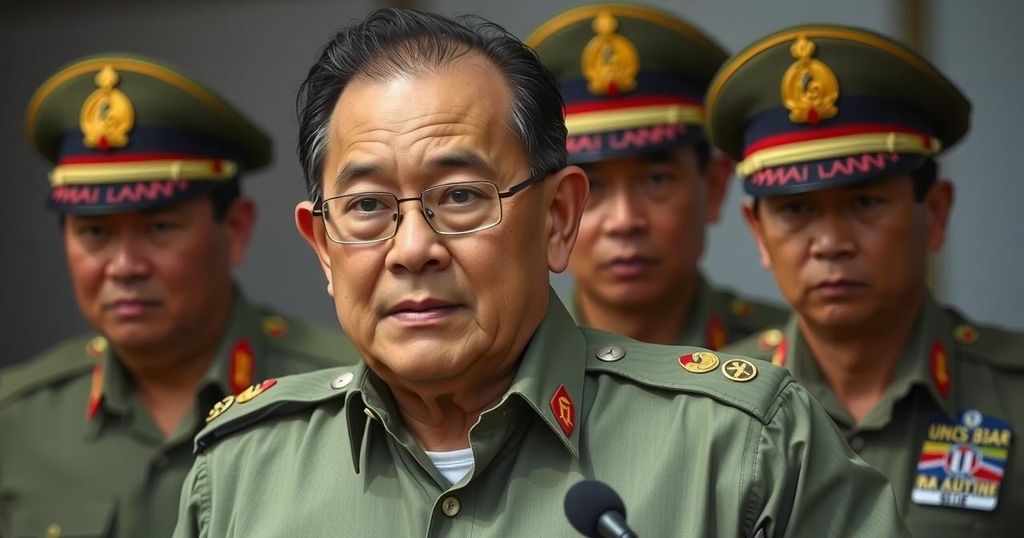Examining the Potential Collapse of the Myanmar Junta After Syria’s al-Assad
The sudden collapse of the al-Assad regime in Syria raises questions about the potential for a similar downfall of the Myanmar junta. Currently, with only twenty percent control of the territory and the military facing severe challenges, internal discord and a lack of international support complicate the situation. Regional powers fear the chaotic aftermath of a junta collapse, contributing to a complex web of challenges preventing the realization of effective change in Myanmar.
Following the abrupt fall of the al-Assad government in Syria, there is growing speculation regarding the potential for the Myanmar junta to experience a similar fate. Analysts and combatants in ongoing civil conflicts are examining Myanmar’s precarious military situation, which has been tenuous since the 2021 coup. Presently, the junta governs only about twenty percent of the nation’s territory while facing deep-rooted resentment among the population, attributed to decades of military rule that have devastated the economy.
The military’s troubles have escalated, marked by significant defections and difficulties sustaining its forces with essential supplies. Furthermore, internal discord among junta leaders might impede coherent military strategy, as numerous high-ranking officials have been dismissed or altered under the command of Min Aung Hlaing. Thus, a disarrayed command structure remains critical as the military has struggled to secure regions such as Mindat, which lies strategically for potential rebel advancement.
Contrasting with Syria, Myanmar presents a more complex landscape with various rebel factions historically at odds, now temporarily united against the junta. However, a rebellion targeting the capital could falter due to inadequate coordination among these groups and the absence of a unifying leader who could orchestrate a peaceful transition post-junta. Aung San Suu Kyi, once a symbol of hope, now lacks the capacity to fulfill this role, given her incarceration and diminished public standing.
The international response to Myanmar’s ongoing crisis is markedly less robust than that directed towards Syria. While there have been sanctions and verbal condemnations aimed at the junta, tangible support for resistance movements remains scant. Especially critical is the decreasing engagement from the United States, which has prioritized other global conflicts over Myanmar. Moreover, the Association of Southeast Asian Nations (ASEAN) has struggled to mediate effectively between opposing sides, compounding the situation’s complexities.
Regional powers, including Thailand, India, and especially China, exhibit hesitance regarding a junta collapse, fearing societal chaos reminiscent of Somalia’s past. These nations prefer a stable governance structure to avoid mass displacement scenarios akin to the Rohingya crisis. Observing Myanmar’s situation, China has extended economic incentives to the junta, emphasizing the importance of maintaining a functional partnership and ensuring its investments remain safeguarded amid the instability.
In summary, while observers draw parallel conclusions to Syria’s regime collapse, the situation in Myanmar entails unique challenges. The interplay of a splintered rebel coalition, limited international support, and regional apprehension about the consequences of a regime change complicate any forecast of a rapid military downfall. Ultimately, the intersection of these factors hinders the semblance of a clear path towards peace and stability in Myanmar’s troubled landscape.
The Myanmar junta’s ongoing struggles stem from a long-standing civil conflict that intensified following the military coup in 2021. The country has been plunged into disarray, with a military government that historically has ruled with an iron fist and has faced growing opposition from a diverse array of ethnic armed groups. The collapse of the al-Assad regime in Syria serves as a cautionary tale for Myanmar, raising critical questions about the potential for upheaval and a shift in power dynamics within the region. Analysts are closely examining the evolving landscape, characterized by diminishing military control and increasing dissatisfaction among the populace.
The Myanmar junta’s potential collapse, akin to that of Syria, underscores a web of complexities surrounding internal dissent, international apathy, and regional interests. While conditions may appear ripe for significant change, prevalent obstacles—including factional discord among rebels, a lack of cohesive leadership, and the surrounding nations’ strategic concerns—complicate any prediction of the junta’s imminent downfall. As such, the path forward remains uncertain, with instability likely to persist unless a unified and effective approach to reconciliation can be forged.
Original Source: www.cfr.org








Post Comment